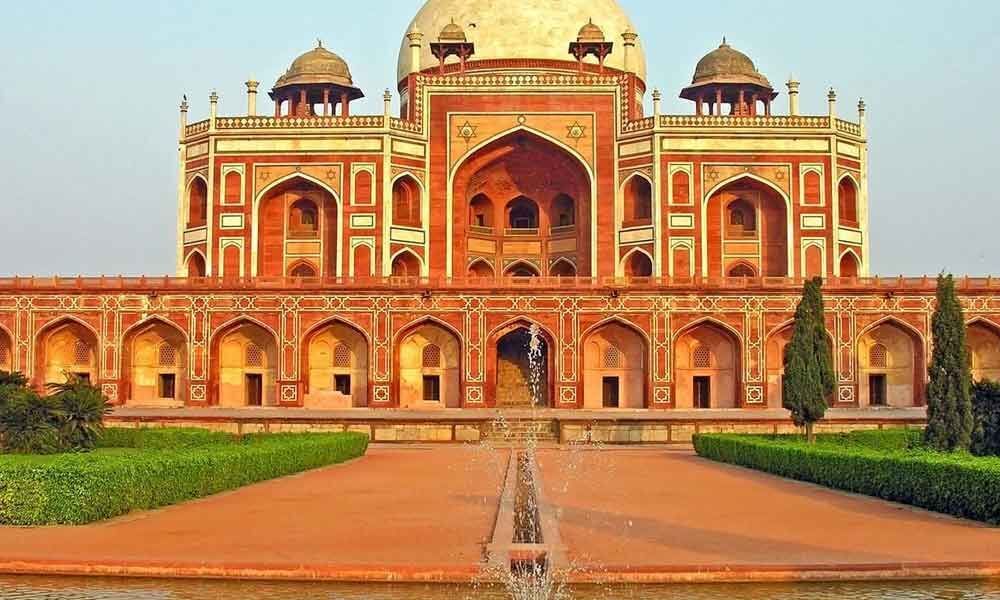Fascinating backstory of Humayun's Tomb

Anyone who crosses Delhis Lodhi-Mathura Road's roundabout would remember a colossal Mughal-era monument that stands on it -- the Subz Burj, hidden under scaffolding for heritage conservation.
Anyone who crosses Delhis Lodhi-Mathura Road's roundabout would remember a colossal Mughal-era monument that stands on it -- the Subz Burj, hidden under scaffolding for heritage conservation.
An example of resplendent Islamic architecture of India, it is the first introduction of a dense ensemble of garden tombs that dot the 170-acre area around the historic red-sandstone Humayuns Tomb built by emperor Akbar.
The green-domed, tall Subz Burj is also one among the several monuments under conservation in the tomb complex, in addition to the over 50 already conserved and open to the public to visit for a small fee.
Sights of master craftspeople and conservation architects at work is not uncommon to find in the massive complex dating back several centuries. Many areas are heavily scaffolded with guarded access, an indication that more architectural masterpieces are yet to open.
A stroll in the beautiful Sundar Nursery city park adjacent to the Tomb, known as Azim Bagh, with the head of key conservator Aga Khan Trust for Culture (AKTC), Ratish Nanda, revealed future plans the global non-profit has for the heritage area.
Saying that the idea for the park is to develop into a high-quality space in the significant cultural landscape where citizens can mingle without the social barriers of religion, caste and class, he said that it proves to be a beautiful example of ecological conservation as well.
The grand 90-acre Sundar Nursery features nursery beds, a flower showcase, arboretum and a microhabitat zone, and is a refreshing relief from the pollution and traffic that mars Delhi otherwise.
Till date, the park boasts of about 280 native tree species, 80 bird species and 36 butterfly species. The nursery, which hosts rich biodiversity in terms of flora and fauna, is also a learning centre.
Madhav, a class 8th student currently studying crops in his science class, shared that he and his classmates are lucky to see live specimens of crops and vegetation in one area, a privilege his parents did not have while growing up.
Speaking on what's next, AKTC CEO Nanda said that work is currently ongoing at important sites like the Rahim's Tomb (mausoleum of one of Akbar's navratna courtiers), Nila Gumbad (a medieval structure with a blue top, pre-dating the Humayun's Tomb), Jamat Khana Masjid (or Khilji Mosque, an early mosque in Delhi's Nizamuddin basti), and Azimganj Serai (an earliest Mughal period Serai), among others.
Last month, the latest addition to the list was a partially-collapsed baoli (water stepwell) in the Arab Ki Serai complex. Funded by Germany, it is expected to be restored and made functional soon.
An underground museum on the cultural significance of the entire restored area is in the pipeline as well.
According to Nanda, who calls this elaborate 10-year project a demonstration of heritage asset management in the Indian context, says that the next 10 years are going to about showing how to manage the heritage painstakingly conserved.
He also added that the complex, which enjoys close to two million visitors annually, will triple its visitors over the next 10 years. "The ticket fee is poured back into the conservation effort."
The nursery is part of the Humayun's Tomb complex, built in the 1560s and woven intricately into the Indian historical fabric.
The grand structure stood tall as a specimen of the Mughal architectural style and a precursor to the Taj Mahal, until it fell into neglect and finally, ruins as Delhi - the seat of Indian power - came to accommodate British rulers.
Conservators point out that the tomb site, like many heritage sites, had befallen a peculiar condition: worn gardens, cracked masonry, and damaged stonework broken.
But, one look at it now, and it seems just as glorious as it would have looked in the sixteenth century.
Its decade-long conservation effort, which took about 60 big and small adjacent monuments into its ambit - thirteen of them now recognised by UNESCO has world heritage sites - has in store a fascinating backstory.
The Trust began work on the site when the 49th Aga Khan -- the Imam of the Shia Ismaili Muslims -- gifted the restoration of the Humayun's Tomb garden to India when it marked 50 years of independence in 1997.
The partnership to develop three key areas -- Humayun's Tomb complex, Sundar Nursery-Batashewala complex and Nizamuddin Basti, which houses a community closely linked to Hazrat Nizamuddin Auliya dargah -- was forged in 2007.
The collaborators include the Archaeological Survey of India, the primary body responsible for heritage sites in India.
Interestingly, the medieval complex, which has over 150 Mughal family members buried in a single place, is in close proximity to the 13th-century Sufi dargah as it was considered auspicious to be buried close a spiritual figure.
Needless to say, the Humayun's tomb, along with tombs and gardens in its vicinity, underwent intense restoration.
The challenges for the AKTC were not just limited to the re-use of glazed Mughal tiles, lime plaster, red sandstone, gold-foiled and copper structures, and replacing damaged wood in the mausoleums and gateways.
They had to remove the encroachment of about 150 modern structures, including a full-fledged journalism institute that ran inside the heritage premise and even undo the damage done by 20th century cement-and-concrete repairs.
Tonnes of cement, which is only a modern building material, plastered on beautiful 16th century architecture had to be replaced with specially-created lime plaster (�choona'). How craftspeople prepared fine lime powder is another case study.
In what is a month-long process, lime mortar is combined with additives like brick powder, sand, jaggery and other ingredients -- making it even more durable than modern-day cement.
It is then mixed in a circular mill built in the ground. This approach, with its seeming two prongs, conserves monuments in its originality, as well as generates employment within the master craftsperson community with indigenous knowledge systems.
"The Indian context is defined by many things. Our craftspeople can work in the same manner, with the same tools, and the same material that was used earlier. In India, you still have to make a case for conservation.
In the whole conservation effort, we've used at least 6,50,000 man-days of work, which is a major employment creator," Nanda said.
After breathing new life into at least 50 monuments - including the notable Nila Gumbad, Isa Khan's garden-tomb, Halima's garden-tomb, Arab Serai gateways, Sundarawala Mahal and Burj, Chausath Khambha, and Hazrat Nizamuddin Baoli - and community life that thrives around it, the conservation effort is spreading its wings to include more tombs, landscapes and baolis, making the ensemble a living, breathing monument.




















